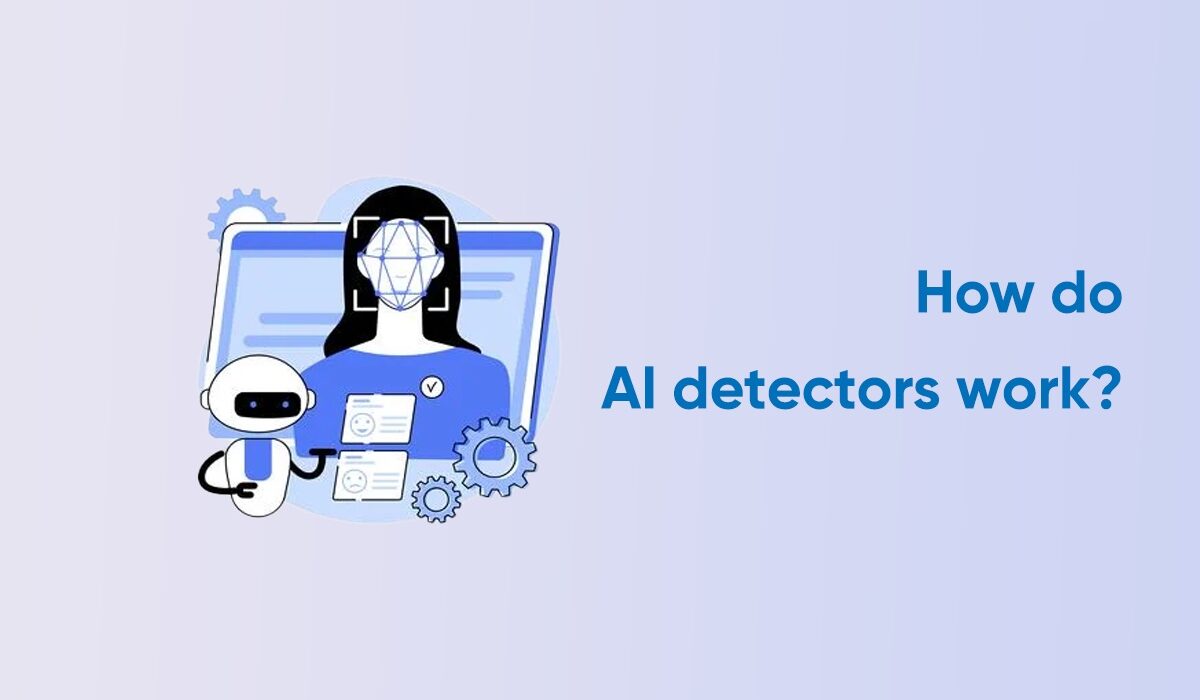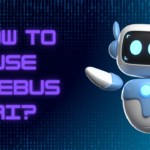How Do AI Detectors Work? Behind the Scenes Actions

AI content detectors work on the phenomenon of machine learning and natural language processing. These detectors catch the linguistic patterns and sentence structures to determine whether the content is AI-generated or human-written.
To know how do AI Detectors Work? We can use the example of Classifiers, Perplexity, and Burstiness. Classifiers categorize text on learned patterns, while the logarithm represents words as vectors to depict their semantic relationships. Perplexity examines the predictability of content, with higher levels suggesting human authorship. Burstiness evaluates the diversity of sentences, with human writing typically exhibiting greater variation. While AI detectors are valuable, they are not infallible and may yield false positives or rejections, necessitating manual review of their reports.
This article will cover the following aspects:
- Understanding what AI content detectors are and how AI detection functions.
- Exploring the methods and technologies employed to detect AI-generated text.
- Assessing the reliability of AI detection tools.
- Differentiating AI content detection tools from plagiarism checkers.
What is an AI content detector? And How Does It Work?

AI content detectors are applications designed to analyse and scrutinize text in real-time to ascertain the involvement of AI in either some portions or the entirety of the text.
There are various reasons for the recent surge in popularity of AI content detectors.
For business owners outsourcing content writing, these detectors prove invaluable in ensuring the received content isn’t merely generated by AI tools without thoughtful input. Moreover, AI content detectors play a vital role in uncovering academic dishonesty. With the proliferation of AI-generated content, educational institutions employ these detectors to combat cheating, particularly in cases of essays produced by AI without proper research.
Additionally, these tools enhance the peer-review process by identifying and eliminating low-quality or inaccurate submissions from academic publications. We believe that it has cleared the idea that “how do AI Detectors Work?” These examples illustrate just a few of the many scenarios in which anti-AI detectors prove beneficial.
You wanna find out how they deliver these aforementioned advantages? Stay tuned with us will the end of this blog.
Do the AI Content Detectors Are Always Right?
AI content detectors demonstrate a reliability rate of 70% based on a sample size of 100 articles. While they offer valuable assistance in identifying AI-generated content, it’s advisable to conduct manual reviews of their findings for enhanced accuracy.
Despite the considerable attention garnered by various AI solutions, it’s important to recognize their relatively recent emergence.
Nevertheless, discussions persist surrounding the efficacy of AI content detection, with some staunchly supporting its capabilities while others remain skeptical. Similar to generative AI tools, AI detectors are still in their early stages and continue to evolve.
One primary reason for this ongoing evolution is the intricacies of language and creativity. It can clear the concept that how do AI Detectors Work because unlike humans, AI detectors do not possess a comprehensive understanding of language; instead, they rely solely on historical data from their training sets to make predictions as accurately as possible. Consequently, this reliance can result in occasional inaccuracies, leading to false positives and negatives.
While AI writing tools offer undeniable utility, they should not be utilized without human oversight due to these inaccuracies, often referred to as AI hallucinations. Moreover, AI detectors face the challenge of keeping pace with the rapid advancements in AI text generators, such as Surfer AI, which can significantly evade detection, blurring the distinction between human and AI-generated content.
The ongoing competition between AI generators and detectors underscores the need to exercise caution and not entirely rely on content detection tools. However, despite the risks, many individuals overly depend on AI for content creation, potentially leading to various issues.
Publishing unverified AI-generated content online poses the risk of spreading misinformation. Although Google does not inherently oppose AI-generated content, pieces containing factual inaccuracies or lacking value are unlikely to rank highly in search engines, particularly concerning YMYL (Your Money, Your Life) topics where accuracy is paramount.
Nevertheless, utilizing an AI detector remains a superior alternative to manually detecting AI writing, as the latter is excessively time-consuming and challenging, even for experienced content managers. Nonetheless, it’s essential to interpret their results with caution.
4 Amazing Ways in Which AI Content Detection Works

AI detectors operate on several key principles and technologies shared with AI text generators. Of these, machine learning (ML) and natural language processing (NLP) stand out as crucial components, enabling detection tools to analyze input and distinguish between AI-generated and human-written content. This information will clear you ideas that how do AI Detectors Work because it explains the AI working methods.
Though multiple approaches exist, four techniques are especially prominent in AI content detection tools.
-
Embeddings
Embeddings serve to represent words or phrases as vectors within a multi-dimensional space. This concept may seem intricate initially, but it becomes more understandable when two fundamental ideas are considered:
-
Vector Representation:
Each word is mapped to a unique point in the space, reflecting its meaning and usage in language.
-
Semantic Web of Meaning:
Words with similar meanings are positioned closer together, forming a cohesive semantic network.
Vectorization holds paramount significance in explaining how do AI Detectors Work because AI models lack inherent comprehension of word meanings, necessitating their conversion into numerical representations through embeddings.
These embeddings are then utilized in feeding models designed to discern between AI and human-written text. Several types of analyses are commonly employed for this purpose:
1. Word Frequency Analysis:
Identifies prevalent or frequently occurring words within content. Over-reliance on statistically common words or phrases is indicative of AI-generated text.
2. N-gram Analysis:
Expands beyond individual words to capture recurring language patterns and phrase structures. Human-written content typically exhibits more diverse N-grams and employs creative language choices.
3. Syntactic Analysis:
Evaluates the grammatical structure of sentences. AI-generated text often adheres to uniform syntactic patterns, while human-authored content demonstrates greater syntactic complexity and varied sentence structures.
4. Semantic Analysis:
Assesses the meaning of words and phrases, considering metaphors, connotations, cultural references, and other nuanced aspects. AI-generated content may misinterpret or omit such nuances, contrasting with human-written text that displays deeper contextual meaning.
Efficient explanation of how do AI detectors work can be resource-intensive because detection of AI-generated content necessitates the integration of these analyses. Additionally, interpreting embeddings with hundreds or thousands of dimensions poses challenges, prompting the need for simplification and dimensionality reduction, albeit a complex endeavor.
Classifiers
As the name suggests, a classifier is an ML model tasked with organizing provided data into predefined categories. Typically, the answer of how do AI detectors work can be taken from labeled training data, which consists of examples already categorized as human or AI-written.
Subsequently, the classifier utilizes the patterns gleaned from the training data to classify new text inputs accordingly.
A classifier can also function with unlabeled data, operating under the unsupervised paradigm. In this scenario, the model autonomously identifies patterns and structures, requiring fewer resources as labeled data isn’t mandatory.
However, unsupervised classifiers may exhibit lower accuracy compared to their supervised counterparts.
Irrespective of the type, a classifier scrutinizes key attributes of the text content (such as tone, style, grammar) to discern patterns common in AI-generated and human-written texts, establishing a boundary between the two.
This boundary, depicted as a line, curve, or other shape depending on the model employed, is determined by various machine learning algorithms, including:
- Decision Trees
- Logistic Regression
- Random Forest
- Support Vector Machines
Upon completion of the analysis, the classifier assigns a confidence score denoting the likelihood of the input text being AI-generated.
It’s essential to note that classifiers may occasionally yield false positives. Let’s explain the how do AI detectors work from given exapmle, if a model is overly trained on specific human writing styles and becomes overfitted, it may categorize deviations from these styles as AI-generated content.
To mitigate such challenges, classifiers should undergo regular updates to adapt to the evolving landscape of AI-generated content.
Burstiness
Burstiness, akin to perplexity, shifts its focus from individual words to entire sentences.
It gauges the overall diversity in sentence structure, length, and complexity, which can markedly differ between AI-generated and human-written text. Burstiness is the perfect example of how do AI detectors work. AI generators often churn out text with limited burstiness, characterized by repetitive words or phrases due to their training data’s influence.
Consequently, AI-generated content may appear monotonous and lacking in creativity or complexity.
Conversely, human-generated content typically exhibits higher burstiness, featuring a mix of short and long sentences with diverse structures and complexities. While burstiness plays a pivotal role in distinguishing between human and AI content, it’s not the sole determining factor.
Given the right prompt, an AI text generator can produce complex text with varied sentence structures, potentially outwitting detection tools overly reliant on burstiness. A proficient AI detector should consider burstiness among various criteria, ensuring a comprehensive approach for more accurate results.
Perplexity
Perplexity serves as a gauge of an AI model’s surprise level for how do AI detectors work. When encountering unfamiliar text, akin to a litmus test for the content’s “humanity.”
When the language choices in the provided text deviate from what the AI model expects, it results in higher perplexity, indicating a more human-like text.
However, relying solely on perplexity for AI detection can lead to misclassifications due to false positives. For instance, nonsensical or jibberish sentences can also trigger high perplexity, regardless of whether they were generated by a human or a machine.
Similarly, novice writers may produce predictable content due to their limited experience or vocabulary, leading an AI detector to mistakenly categorize it as AI-generated.
Therefore, perplexity is more accurate when used in conjunction with contextual analysis, allowing the model to better comprehend the text’s meaning beyond mere predictability.
Some Prominent Technologies Behind AI Content Detection

Regardless of the method employed for how do AI detectors work, two key technologies are integral to the process:
- Natural Language Processing
- Machine Learning
Wanna briefly discuss how these technologies underpin AI detection tools? Let’s Find out:
Natural Language Processing
Much like NLP is crucial for AI text generation, it can be used to detect AI-generated content.
It allows AI detectors to understand the many linguistic and structural nuances of the provided text, including context and syntax.
These are some of the main features that differentiate human and AI content.
AI content might not be as stylistically rich as a human-written piece, lacking creative linguistic choices and contextual cues that most AI writing tools miss.
Natural language processing techniques are also utilized to delve into the semantics of the provided text and assess the depth of meaning.
This is another aspect of content creation where human writers have a significant advantage. As AI models might struggle to grasp the contextual subtleties that make a world of difference in a text. It can briefly explain how do AI detectors work.
In addition to ML and NLP, several supporting technologies facilitate AI detection, most notably:
-
Text Analysis Algorithms:
Scrutinize the structure and stylistic elements of the given text to assist an AI detector in assessing the content’s main elements (length, complexity, vocabulary usage, etc.)
-
Data Mining:
Aids AI tools in detecting patterns by extracting them from large datasets
Machine Learning
Machine learning enables AI detectors to identify patterns in large datasets.
These patterns can pertain to the content’s sentence structures, contextual coherence, and various other features that distinguish human-written content from pieces generated by an AI tool.
Depending on the model’s specifications and the datasets it was trained on, AI content can be detected by either the presence or absence of familiar patterns.
For instance, if an AI detection tool was trained on content generated by an AI language model, any overlap between the patterns identified in the training dataset and new content will indicate AI-generated content.
In addition to identifying that how do AI detectors work, machine learning facilitates predictive analysis—the ability to accurately predict which word should come next in a sentence.
Perplexity heavily relies on predictive analysis, as a lack of “surprises” during prediction indicates the use of AI.
Comparison Between AI Detectors and Plagiarism Checkers
AI detection tools serve the same general purpose as plagiarism checkers—uncovering dishonesty in writing. However, these tools differ significantly in their underlying mechanisms.
As mentioned earlier, AI detectors analyze the features of the provided text to identify patterns consistent with AI or human-written text. This process is intricate and involves various advanced technologies and processes.
In contrast, a plagiarism checker operates on a much simpler basis.
It compares the content against an existing database of resources to identify direct matches or close similarities. Depending on the method employed, plagiarism checkers may search for keywords, phrases, or specific content fragments present in the database.
It’s worth noting that most AI writing tools, particularly capable ones, are trained to avoid plagiarism.
Nevertheless, they may still produce derivative content, particularly in the absence of sufficient input and detailed prompts.
How to Turn AI-Generated Content into Human Written Text and Pass the AI Content Detection

Surfer AI enables the creation of search engine-optimized articles that mimic human-like writing and can evade AI content detectors.
While Google and other search engines typically don’t penalize AI-generated content unless it’s solely intended for manipulating rankings and traffic. The method of how do AI detectors work can leverage AI content to expedite the content creation process while maintaining cost-effectiveness and efficiency.
According to Google’s Search Central blog post on AI content guidelines,
It can be advantageous to use AI content to streamline content creation processes while managing costs and efforts effectively.
By utilizing Surfer’s anti-AI feature, you can produce content that convincingly resembles human-authored writing.
Surfer generates an outline that you can customize and direct the writer to include specific information.
Within approximately 20 minutes, you’ll have an article that successfully bypasses AI content detection and is ready for publication.
After pasting the text into Originality’s AI detection tool, the resulting score indicates:
98% human-written content and 2% AI-generated content.
8 Key Takeaways of How Do AI Detectors Work From this Article:
- AI content detectors analyze the linguistic and structural aspects of content to distinguish between human-written and AI-generated text.
- This detection process is essential for identifying low-quality content that requires editing and fact-checking before publication. It also aids in identifying academic dishonesty and the excessive use of AI in research papers and similar publications.
- Classifiers, one of the most commonly employed AI detection tools, identify patterns indicative of AI-generated or human-written text to delineate between the two.
- Embeddings are integral to AI content detection, facilitating the analysis of various key features within the provided text to determine its origin.
- Perplexity and burstiness are significant indicators of whether text is human or AI-generated. AI involvement is often evident in predictable and monotonous sentence structures.
- Similar to AI text generators, AI detection tools rely on Natural Language Processing (NLP) and Machine Learning (ML). NLP enables a thorough examination of linguistic and structural features, while ML facilitates pattern detection and recognition.
- Despite their usefulness, AI content detectors should not be relied upon completely due to the prevalence of false positives and negatives.
- AI detectors are commonly used alongside plagiarism checkers to detect different forms of writing dishonesty. While they share a common objective, their underlying mechanisms differ significantly, with AI detectors employing more advanced technologies.
Final Words
In conclusion, AI detection poses a significant challenge in today’s content landscape, especially as AI writing tools continue to advance.
While these tools become more sophisticated, they still lack the nuanced understanding of language that humans possess. This gap is where capable AI detection tools come into play, as they can discern subtle differences that indicate whether content was created by a human or a machine.
However, it’s essential not to place complete trust in AI detection tools because how do AI detectors work can not be as simple as it looks. Like any technology, they are not infallible. Instead, it’s crucial to take the time to assess the content yourself, rather than solely relying on the tool’s judgement. In the end, the quality and value of the content should be your primary consideration.
More Read: Does Character AI Save Chats? A Guide to Stay Safe from Hackers in 2024










